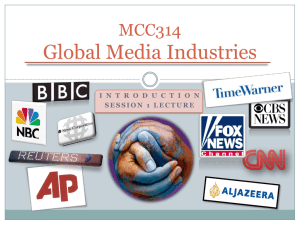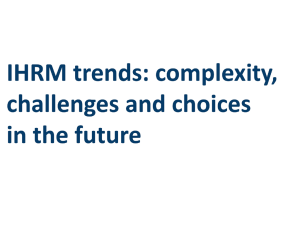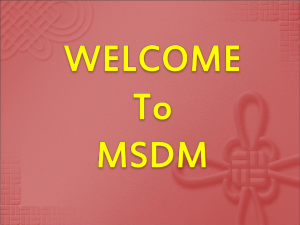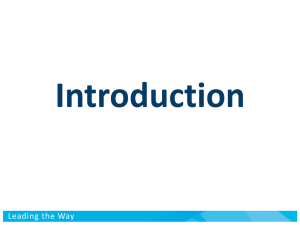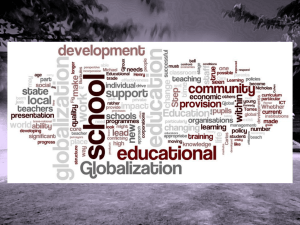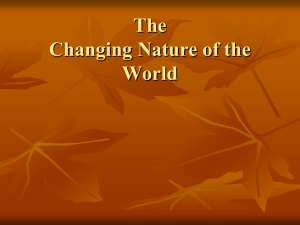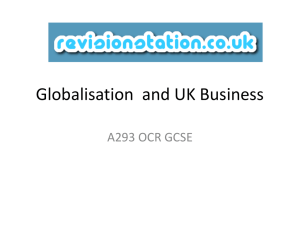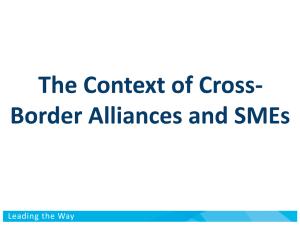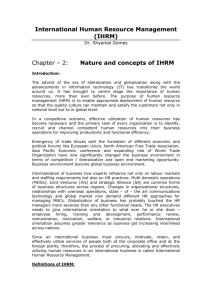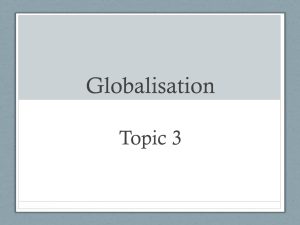ihrm - WordPress.com
advertisement
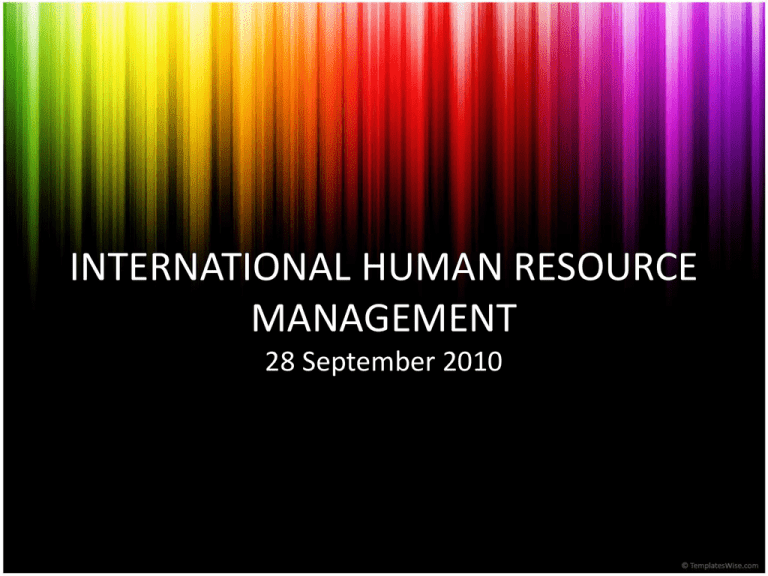
INTERNATIONAL HUMAN RESOURCE MANAGEMENT 28 September 2010 INTRO Dony Eko Prasetyo Education Background: • S1 : International Relation Department, FISIP, Airlangga University • S2 : Magister Management Program, majoring HRM, Faculty Economics and Business, Airlangga University Peminatan Study: International Politics, Internasional Business, International Political Economy, Organization Behavior, Across Culture Management Work experience: • Lecturer assistance in Indonesia Foreign Affairs subject and Geopolitics and geostrategic subject (2006 – 2007) • Senior Merchandiser, PT. Eratex Djaja, Tbk. (2007 – 2009) • Outsourcing Staff in Cooperation Division Surabaya City Government, sub division foreign affairs (2009 – 2010) Contact details: Email: dony.eko.prasetyo@gmail.com dony_eko_prasetyo@yahoo.com YM: donyekoprasetyo; dony_eko_prasetyo; Skype: dony_eko_prasetyo; Meebo: prast2912 IHRM • Subject : International Human Resource Management • Credits : 3 credits / 150 minutes • Material : please download it on http://donyekoprasetyo.wordpress.com/mate ri-kuliah/international-hrm/ References • Dowling, Peter. J. and Denice E. Welch. 2004. International Human Resource Management. 4th Edition. Italy: Thomson Learning. • Harzing, Anne-Wil and Joris Van Ruysseveldt. 2004. International Human Resource Management. 2nd Edition. London: Sage Publication. Study Contract • Lateness: 15 minutes • Assignment: – Individual task (case study) – Group task (presentation) – Big task (presentation) GLOBALIZATION ?????? The process by which different parts of the world interact economically, politically, and culturally. What is Globalization? • 'Globalization means when your e-mail account is full with spam from countries you've never heard of...' "Before this Global Warming, I never knew what grass was." The Definition of Globalisation • Globalization - the 'big idea' of the late twentieth century lacks precise definition. More than this, it is in danger of becoming, if it has not already become, the cliché of our times. • Nonetheless, the term globalization captures elements of a widespread perception that there is a broadening, deepening and speeding up of world-wide interconnectedness in all aspects of life, from the cultural to the criminal, the financial to the environmental. • At issue appears to be 'a global shift'; that is, a world being moulded, by economic and technological forces, into a shared economic and political arena. The Definition of Globalisation • Globalization can usefully be conceived as a process (or set of processes) which embodies a transformation in the spatial organization of social relations and transactions, generating transcontinental or interregional flows and networks of activity, interaction and power The Definition of Globalisation Globalisation can be defined as the intensification of world-wide social relations which link distant localities in such a way that local happenings are shaped by events occurring many miles away and vice versa. (Anthony Giddens, 1990) The Definition of Globalisation Globalisation refers to all those processes by which the peoples of the world are incorporated into a single world society, global society. (Martin Albrow, 1990) The Definition of Globalisation • The world is becoming a global shopping mall in which ideas and products are available everywhere at the same time. (Rosabeth Moss Kanter 1995) • Globalisation is what we in the Third World have for several centuries called colonisation. (Martin Khor 1995) The Definition of Globalisation Globalisation refers to the process whereby social relations acquire relatively distanceless and borderless qualities, so that human lives are increasingly played out in the world as a single place. (Jan Aart Scholte, 1997) History of Globalization • Sharing between world cultures began 1000s of years ago. • In the 19th century cultural sharing exploded. 19th Century • • • • Europeans discover the Americas European Imperialism Industrial Revolution Inventions – Transportation – Telephone – Telegraph 20th Century • Free market capitalism – End of the Cold War • THE INTERNET – Exchange ideas – Transfer $$ – Share culture – 24/7 The World Today • This world is structured into three tiers: –Core Regions –Semi-Peripheral Regions –Peripheral Regions Core: Dominate and control world-system Core Regions • Dominate world trade • Control the most advanced technologies • Have high levels of productivity and diversified economies • Characterized by the highest standards of living Triad of North America, EU, and Japan Periphery: dependent trading relationships Peripheral Regions • “Slow World” • Low levels of technology • Underdeveloped or narrowly specialized economies • Low levels of productivity • Low standards of living Semi-periphery: In-between… Semi-Periphery • Able to exploit peripheral nations • Exploited by core nations • Once were peripheral but changed status – The tiers are fluid MSDM DAN PERKEMBANGAN GLOBAL o Globalisasi : kecenderungan perusahaan/organisasi memperluas penjualan atau manufakturing mereka ke pasar baru di luar negeri. Akibatnya menimbulkan tren dunia kerja dlm aspek teknologi yang melahirkan dunia jabatan dan kerja.(Dessler,1997). o Tantangan MSDM (Mathis dan Jackson,2006) : Perubahan ekonomi dan teknologi; Ketersediaan dan kualitas angkatan kerja; Pertumbuhan angkatan kerja tidak tetap; Persoalan demografi; Penyeimbangan pekerjaan/keluarga; Penyusunan ulang organisasional dan merger/akuisisi MSDM DAN PERUBAHAN GLOBAL Tidak ada organisasi yang bergerak dalam keadaan terisolasi. Tidak ada organisasi yang boleh mengambil sikap tidak perduli terhadap apa yang terjadi dalam lingkungan dimana ia bergerak (Hasibuan, 2003). Globalisasi mempengaruhi diri manajer dalam hal keterampilan mengelola orang. Harus mampu bekerja dengan orang dari budaya yang berbeda, seperti :pada saat ditugaskan ditempat lain; di negara sendiri (memahami budaya, gaya manajemen, memodifikasi) Perkembangan baru dalam manajemen personalia dan SDM :keterbukaan,produktivitas, orientasi sistem,efektivitas, strategi, IHRM Using of global resource to get organization objective without see geographic border Three Approaches to IHRM • Cross-cultural management Examine human behavior within organizations from an international perspective • Comparative HRM and Industrial Relations Seeks to describe, compare and analyze HRM systems and IR in different countries • HRM in multinational firms Explore how HRM is practiced in multinationals Interrelationships between Approaches of IHRM Diversity as an Organizational and HR Challenge in MNE Source: Marilyn Loden and Judy B. Rosener, Workforce America: Managing Employee Diversity as a Vital Resource, p. 20. What does IHRM add into the Traditional Framework of HRM? • Types of employees – Within and cross-cultural workforce diversity – Coordination – Communication • Human resource activities – Procurement – Allocation – Utilization of human resources • Nation/country categories where firms expand and operate – Host country – Parent country – Third country A Model of IHRM 1–42 What is an expatriate? An employee who is working and temporarily residing in a foreign country • Some firms prefer to use the term “international assignees” • Expatriates are PCNs from the parent country operations, TCNs transferred to either HQ or another subsidiary, and HCNs transferred into the parent country Global flow of HR: more complexity in activities and more involvement in employees' lives 1–43 International Assignments Create Expatriates: 1–44 Differences between Domestic HRM and IHRM More HR activities The need for a broader perspective More involvement in employees’ personal lives Changes in emphasis as the workforce mix of expatriates and locals varies Risk exposure Broader external influences 1–45 Variables that Moderate Differences between Domestic HR and IHRM 1–46 Factors that Influence the Global Work Environment 1–47
